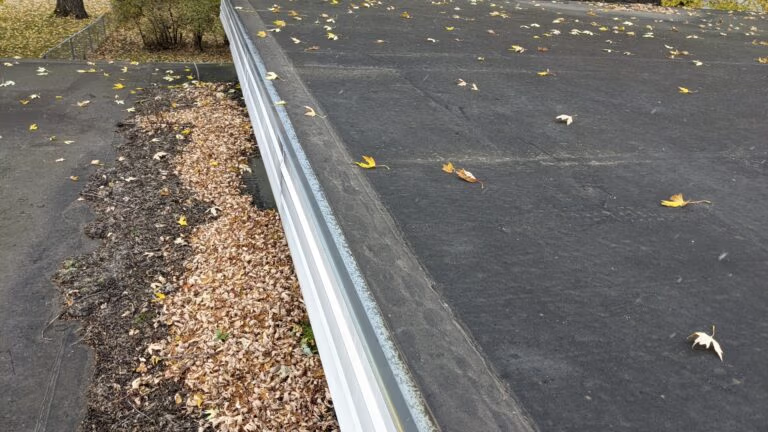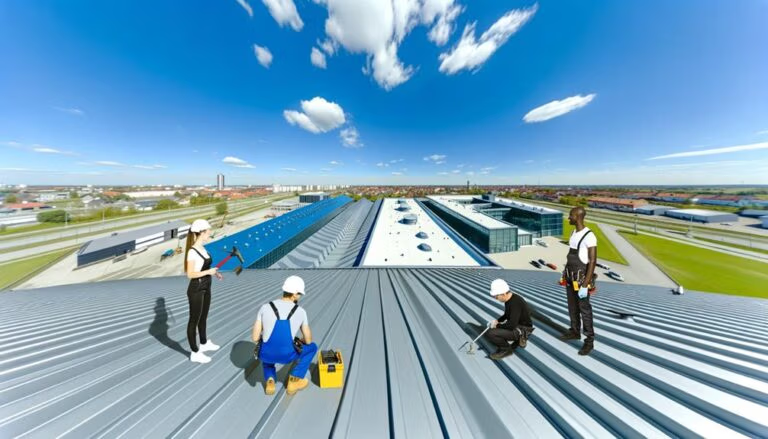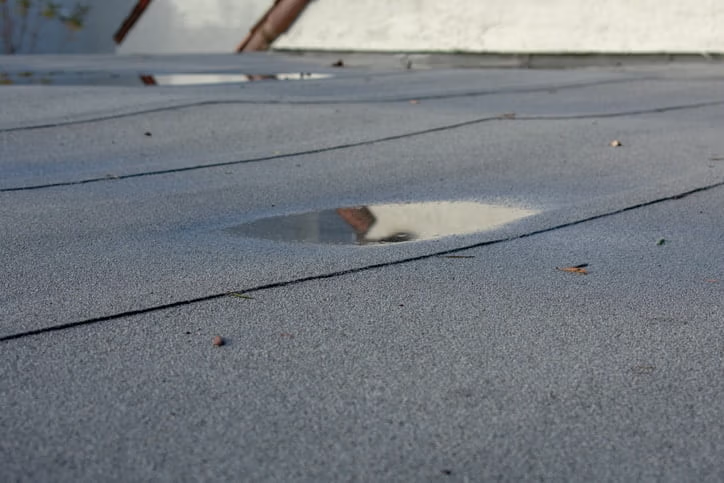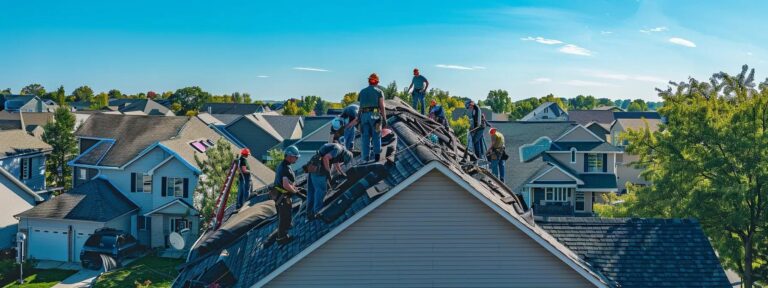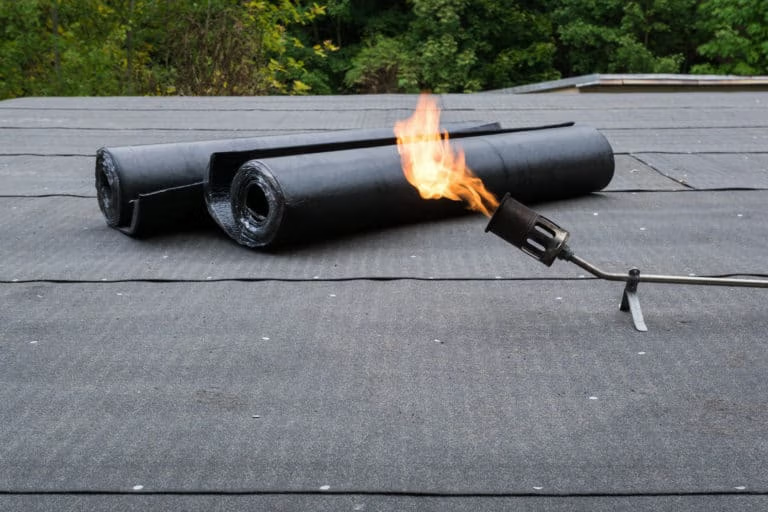Frequently Asked Questions
What is the ideal deck height for a rubber roof?
The ideal deck height for a rubber roof is typically 6 to 12 inches above the roof surface. This height allows for proper drainage and ventilation between the deck and roof membrane.
How do I handle roof deck ventilation on a flat rubber roof?
To properly ventilate a deck on a flat rubber (TPO) roof, install sleepers or pedestal systems to create an air gap between the deck and roof membrane. This allows airflow and prevents moisture buildup.
Can I add railings to a deck on a rubber roof?
Yes, you can add railings to a deck on a rubber (TPO) roof. The deck is typically constructed using a pedestal system that creates a stable, level surface on top of the roof membrane. The railings can be securely attached to the deck structure without penetrating the roof.
What is the load capacity of a flat rubber roof for a deck?
The load capacity of a flat rubber (TPO) roof for a deck depends on several factors, including the thickness of the TPO membrane, the structural integrity of the roof, and the weight of the deck and any additional loads. It is recommended to consult with a professional roofer or structural engineer to determine the specific load capacity for your roofing system.
What are the essential tools needed to build a deck on a rubber roof?
To build a deck on a rubber (TPO) roof, you'll need the following essential tools:
80-mil TPO membrane
Sleepers or pedestals to create a level surface
Fasteners compatible with the TPO roof
Power tools for cutting and installing the deck
Sealants and adhesives to ensure a watertight installation
How long does TPO decking last?
TPO (Thermoplastic Polyolefin) decking can typically last 15-20 years with proper installation and maintenance. The lifespan depends on factors like exposure to UV, foot traffic, and weathering.
What materials are needed to build a deck on a flat roof?
To build a deck on a flat roof, you will need the following materials:
80-mil TPO membrane
Sleepers or pedestals to create a level surface
Deck boards or pavers suitable for outdoor use
How do I handle drainage when building a deck on a rubber roof?
To properly handle drainage when building a deck on a rubber roof:
Install drainage mats or channels between the roof membrane and the deck to allow water to flow away.
Ensure the roof has adequate slope to promote drainage and prevent ponding.
Use pedestals or supports that elevate the deck above the roof surface to facilitate water flow.
Can I build a deck directly on a flat rubber roof?
Yes, it is possible to build a deck directly on a flat rubber (TPO) roof. These types of decks are often referred to as "floating" decks, as they are not anchored into the roof structure. However, proper installation of sleepers and a pedestal system is required to ensure the deck is level and to protect the roof membrane.
Do I need a roof deck waterproofing membrane?
Yes, a waterproofing membrane is essential when building a deck over a TPO roof to prevent leaks and ensure long-term durability. An 80 mil TPO membrane is recommended to provide reliable protection against water infiltration.
How much does TPO decking cost?
The cost of a TPO deck can range from $25 to $35 per square foot, depending on the size, materials, and complexity of the installation. Additional factors like labor and permits can also impact the total cost.
What is the cost of building a deck on a flat rubber roof?
The cost of building a deck on a flat rubber (TPO) roof can vary depending on factors like the size of the deck, materials used, and labor costs. On average, it can range from $20 to $50 per square foot, including the cost of the TPO membrane, sleepers, and pedestal system.
How do I secure the deck to the rubber roof?
To secure a deck to a rubber (TPO) roof, use a pedestal system designed for the application. The pedestals create a level surface while preventing damage to the roof membrane.
How do I finish the edges of a deck on a rubber roof?
To finish the edges of a deck on a rubber (TPO) roof, use a termination bar or edge flashing to securely attach the deck to the roof membrane. Seal the edges with a compatible sealant to prevent leaks.
How long does it take to build a deck on a flat rubber roof?
Building a deck on a flat rubber (TPO) roof typically takes 1-2 days for installation once the roof surface is properly prepared with sleepers and a pedestal system to create a stable, level platform.
How do I attach deck boards to a flat rubber roof?
To attach deck boards to a flat rubber (TPO) roof, use a pedestal system designed for this purpose. The pedestals provide a stable, level platform to support the deck while maintaining the roof membrane's integrity.
How do I ensure waterproofing when building a deck on a rubber roof?
Use an 80-mil TPO membrane to waterproof the roof surface. Install sleepers on top of the membrane and secure the deck structure to the sleepers. Utilize pedestal systems to create a level, stable deck over the roofing.
How do I ensure drainage on a flat rubber roof deck?
To ensure proper drainage on a flat rubber roof deck, use an 80-mil TPO membrane, install sleepers to create a slope, and incorporate a pedestal system to elevate the deck above the roof surface.
How thick should the deck frame be on a flat rubber roof?
The deck frame on a flat rubber (TPO) roof should be at least 2 inches thick to provide adequate support and prevent damage to the roofing membrane. Thicker framing, such as 4x4 or 6x6 lumber, may be required depending on the load-bearing requirements.
What is the best decking material for a flat rubber roof?
For a flat rubber roof, the best decking material is typically pressure-treated plywood or composite decking. These materials are durable, weather-resistant, and compatible with the roof's membrane. Proper installation using pedestals or sleepers is crucial to maintain the roof's integrity.
Can I build a deck on a rubber roof with a slope?
Yes, you can build a deck on a rubber roof, also known as a TPO (Thermoplastic Polyolefin) roof. These decks are typically "floating" decks, meaning they are not anchored directly to the roof structure. Specialized pedestal systems can be used to create a level, stable deck over the roof membrane.
Can I use a floating deck system on a flat rubber roof?
Yes, you can build a floating deck system on a flat TPO (thermoplastic polyolefin) roof. These decks are not anchored in place but instead placed directly on top of the roof surface, typically using sleepers or pedestal systems to create a stable and level platform.
Can I use a deck membrane on top of a rubber roof?
Yes, you can install a deck membrane on top of a rubber (TPO) roof. Pedestal systems are available that create a sturdy, level deck over the roof membrane, without penetrating it.
What type of flashing is required for a deck on a rubber roof?
To properly install a deck on a rubber (TPO) roof, you'll need to use a pedestal system with sleepers that sits above the roof membrane. This creates a level, stable base for the deck without directly penetrating the waterproof roof.
How do I inspect and maintain a deck on a rubber roof?
Inspect the deck and rubber roof regularly for signs of damage or wear. Clean the surface and ensure proper drainage. Reseal or replace the roof membrane if needed to prevent leaks. Use specialized fasteners and supports designed for rubber roofs.
What are the weight limitations for a deck on a rubber roof?
The weight limitations for a deck on a rubber (TPO) roof depend on the specific roof system and design. Consulting a structural engineer is recommended to ensure the roof can safely support the additional deck load.
How do I prepare a rubber roof for deck construction?
To prepare a rubber roof (TPO) for deck construction:
Use an 80 mil or thicker membrane to prevent ripping.
Install sleepers on top of the roof surface to create a level base for the deck.
Utilize pedestal systems designed for roof decks to ensure a sturdy, level deck.
How do I measure the rubber roof for deck installation?
To measure a rubber (TPO) roof for deck installation:
Measure the roof area where the deck will be placed.
Add an extra 6-12 inches on all sides to allow for proper sealing and attachment.
Measure the height from the roof surface to the desired deck height.
Determine the pedestal or sleeper system height required to achieve the desired deck elevation.
What is the recommended deck material for a rubber roof?
The recommended deck material for a rubber (TPO) roof is a pedestal system. These pedestal systems provide a sturdy, level, and serviceable deck over the roof membrane.
Do I need to consult a professional for deck construction on a rubber roof?
Yes, consulting a professional is recommended for deck construction on a rubber (TPO) roof. Proper installation techniques and waterproofing measures are crucial to prevent leaks and damage to the roof membrane.
What kind of roof deck fasteners should I use?
For a TPO roof deck, you should use pedestal systems or sleepers that are compatible with the roof membrane and provide a secure, level surface for the deck. These specialized systems are designed to prevent damage to the roof and ensure long-term waterproofing.
What are the load calculations for a deck on a rubber roof?
The load calculations for a deck on a rubber roof must account for the weight of the deck, any furnishings or equipment, and snow or wind loads. A structural engineer should be consulted to determine the appropriate design and ensure the roof can safely support the added load.
What type of deck framing is suitable for a rubber roof?
Floating or pedestal deck systems are suitable for rubber (TPO) roofs. These systems do not penetrate the roof membrane, preventing leaks. Pedestal systems provide a stable, level surface above the roof.
Can I build a multi-level deck on a rubber roof?
Yes, you can build a multilevel deck on a rubber (TPO) roof. These decks are commonly referred to as "floating decks" as they are not anchored directly to the roof structure. Install sleepers and a pedestal system to create a stable, level deck surface over the roof membrane.
Do I need to hire a professional to build a deck on a flat roof?
Yes, it is recommended to hire a professional to build a deck on a flat TPO roof. Proper installation techniques and waterproofing measures are crucial to prevent leaks and damage to the roof membrane.
How do I prepare a flat rubber roof for deck construction?
To prepare a flat rubber roof (TPO or EPDM) for deck construction:
Use an 80-mil or thicker membrane to prevent ripping.
Install sleepers or pedestals on the roof to create a level base for the deck.
Ensure proper waterproofing to prevent leaks and damage to the roof and home.
How should insulation be layered under TPO decking?
Install a layer of rigid insulation boards over the TPO roof membrane, ensuring proper coverage and sealing of seams.
Add a second layer of insulation, such as perlite or polyisocyanurate, to achieve the desired R-value.
Secure the insulation layers with approved fasteners and create a smooth, level surface for the deck installation.
What safety measures are crucial during deck construction?
Wear appropriate personal protective equipment (PPE) such as hard hats, gloves, and safety glasses.
Secure the work area with barriers and warning signs to prevent unauthorized access.
Follow proper lifting techniques and use mechanical aids to avoid back injuries.
Ensure all tools and equipment are in good working condition and used correctly.
Maintain a clean and organized work environment to minimize tripping and falling hazards.
Should I consider thermal expansion for TPO decking?
Yes, thermal expansion is an important consideration when installing a TPO deck. TPO roofing material expands and contracts with temperature changes, so the deck system must be designed to accommodate this movement to prevent damage to the roof membrane.
How do you integrate deck railing with TPO?
When building a deck over a TPO roof, use a pedestal system to create a level surface. Attach the deck railing posts directly to the pedestal system, ensuring a secure and watertight connection to the roof membrane.
What deck design supports optimal water runoff?
A floating deck or pedestal deck system designed for flat roof applications can provide optimal water runoff. These decks are placed on top of the roof membrane without penetrating it, allowing water to properly drain.
How do I reinforce a rooftop deck structure?
To reinforce a rooftop deck structure, use an 80-mil TPO membrane, install sleepers for a sturdy, level base, and utilize specialized pedestal systems to create a durable, watertight deck over the roof.

